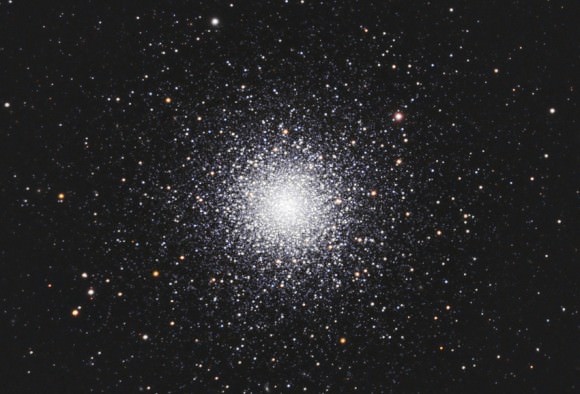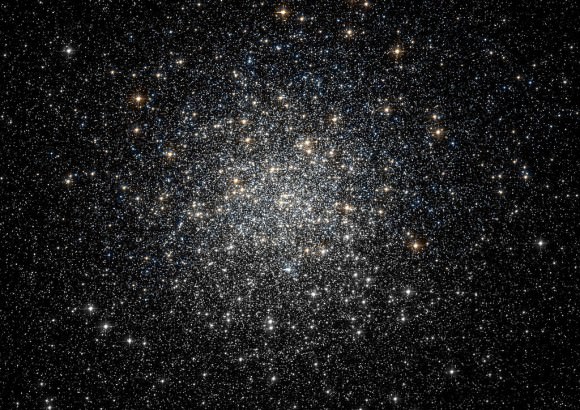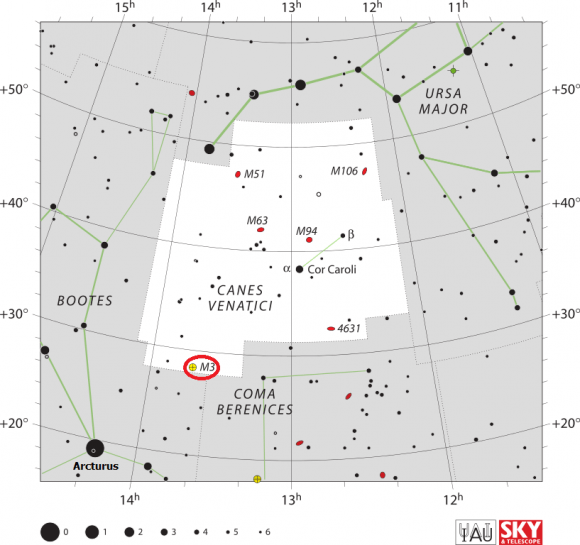During the late 18th century, Charles Messier began to notice a series of "nebulous" objects in the night sky which he originally mistook for comets. With the hope of preventing other astronomers from making the same mistake, he began compiling a list of these in what would come to be known as the
Messier Catalo
g. Consisting of 100 objects, the catalog became an important milestone in the discovery and research of Deep Sky objects.
One such object is Messier Object 3 (aka. M3 or NGC 5272) globular cluster that is located in the northern constellation of Canes Venatici. Since it was first observed, this globular star cluster has gone on to become one of the best-studied objects in the night sky, and is considered by many amateur astronomers to be one of the finest visible clusters.
moreDescription:
M3 is one of the largest and brightest star clusters, and is made up of around 500,000 stars. It is located at a distance of about 33,900 light-years from Earth, the cluster spans about 220 light-years. It is estimated to be 8 billion years old, making M3 one of the oldest formations in our galaxy. To put that in perspective, this nebula was already half its current age when our own Sun was formed.
Despite the fact that it is farther from us than the center of our own galaxy, M3 is visible with just the slightest of optical aid. This is largely because it contains 274 known variable stars, which is by far the highest number found in any globular cluster. It contains at least 133 RR Lyrae variables - along with a surprising number of Blue Straggler Stars - blue main-sequence stars which appear youthful.
[caption id="attachment_127426" align="aligncenter" width="580"]
Globular Cluster Messier 3, as seen with amateur telescopes. Credit: Wikipedia Commons/Hewholooks
[/caption]
Since all stars in globular clusters are believed to be about the same age, it is possible these stars have had their outer layers stripped away while passing through the dense core region of M3. Messier 3 also commands about 760 light years of space - meaning that it keeps all stars within that distance tied to its rich core. The overall abundance of elements other than hydrogen and helium, Messier also has a relatively high abundance of heavier elements - making it "metal-rich".
History of Observation:
Oddly enough, when Charles Messier first noticed this object - on May 3rd, 1764 - it was only the 76th Deep Sky Object ever seen by human eyes (with the assistance of telescopes, that is). Although Charles had logged his previous two discoveries (the M1 "Crab Nebula" and the globular cluster M2) it was this third object that prompted him to begin his now famous catalog of 'objects that are not comets'.
As Messier recorded at the time in in his notes:
[caption id="attachment_127429" align="aligncenter" width="580"]
Image of M3, based on observations made with the NASA/ESA Hubble Space Telescope, and obtained from the Hubble Legacy Archive. Credit: STScI/NASA/ST-ECF/ESA/CADC/NRC/CSA.
[/caption]
And as with other objects recorded by Messier, it was Sir William Herschel who first resolved the M3 into stars. As he recorded in his own observational notes:
But none described it more eloquently than Admiral William Henry Smyth - an English astronomer and naval officer. As he wrote:
Locating Messier 3:
For binoculars, the easiest way to discover this ancient beauty is to look about halfway between the pair of Arcturus and Cor Caroli, just east of Beta Comae. Many times, just starting at Arcturus and sweeping slowly up towards Cor Caroli is enough! If you still have trouble, locate the Coma Berenices star cluster (Melotte 111) and look east about a fist width.
[caption id="attachment_127428" align="aligncenter" width="580"]
Location of Messier 3 in the Cane Venatici constellation. Credit: IAU/skyandtelescope.com
[/caption]
You'll find it 6 degrees north-northeast of Beta Comae and it will show very easily in the finderscope. In binoculars of all sizes and even under urban lighting conditions, Messier 3 is very bright and will begin to show some signs of resolution with larger models, such as 10X50. Even small telescopes will see individual stars come to life and it will explode into a fine, pinpoint mass in telescopes as small as 6".
And for your convenience, here are the vital statistics on M3, aka NGC 5272:
- Object Name
-
Messier 3
- Alternative Designations
-
NGC 5272
- Object Type
-
Class VI Globular Cluster
- Constellation
-
Canes Venatici
- Right Ascension
-
13 : 42.2 (h:m)
- Declination
-
+28 : 23 (deg:m)
- Distance
-
33.9 (kly)
- Visual Brightness
-
6.2 (mag)
- Apparent Dimension
-
18.0 (arc min)
As always, good luck with your search, and may your observations be rich!
We have written many interesting articles on Messier Objects here at Universe Today. For instance, here's Tammy Plotner's
Introduction to the Messier Objects
,
M1 – The Crab Nebula
, and David Dickison's articles on the
2013
and
2014
Messier Marathons.
Be to sure to check out our complete
Messier Catalog
.
For more information, check out the
SEDS Messier Database
.
 Universe Today
Universe Today



